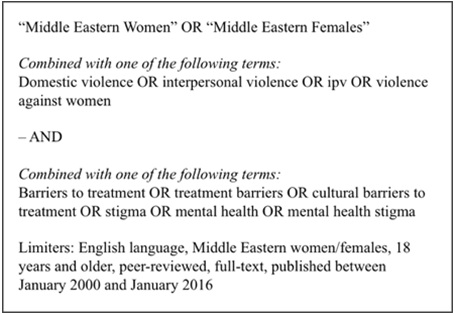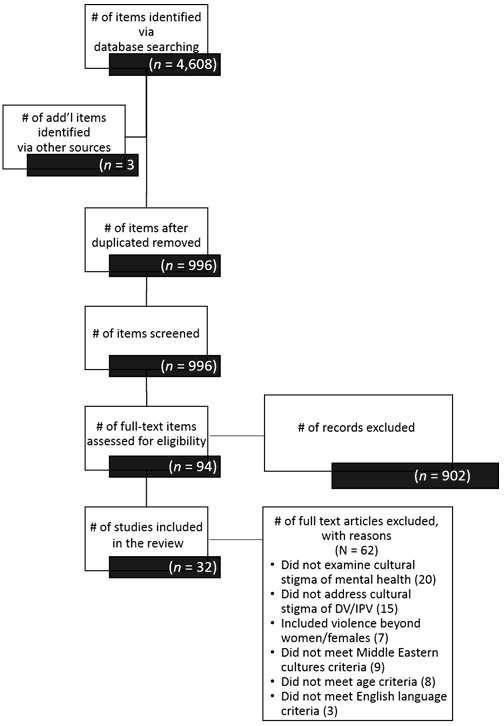1. Ellsberg M, Heise L. Researching violence against women: A practical guide for researchers and activists. https://www.popcouncil.org/uploads/pdfs/horizons/whopathresviolappb.pdf. 2005.
2. Hawcroft C, Hughes R, Shaheen A, et al. Prevalence and health outcomes of domestic violence amongst clinical populations in Arab countries: A systematic review and meta-analysis. BMC public health. 2019; 19(1): 315. doi: 10.1186/s12889-019-6619-2
3. Breiding MJ, Chen J, Black MC. Intimate Partner Violence in the United States-2010. National Center for Injury Prevention and Control, Centers for Disease Control and Prevention. https://www.cdc.gov/violenceprevention/pdf/cdc_nisvs_ipv_report_2013_v17_single_a.pdf. 2014.
4. Pallitto C, García-Moreno C, Jansen H, et al. Intimate partner violence, abortion, and unintended pregnancy: Results from the who multi-country study on women’s health and domestic violence. Int J Gynaecol Obstet. 2013; 120(1): 3-9. doi: 10.1016/j.ijgo.2012.07.003
5. Catalano SM. Intimate partner violence, 1993-2010. https:// www.bjs.gov/content/pub/pdf/ipv9310.pdf. Revised September 29, 2015. 2012.
6. Tjaden PG, Thoennes N. Extent, Nature, and Consequences of Intimate partner Violence: Findings from the National Violence Against Women Survey. Wolcott, NY, USA: Scholar’s Choice; 2000.
7. Chan B. Capitalising on the social resources within culturally and linguistically diverse communities for mental health promotion: Stories of Australian Chinese people. Australian Journal of Primary Health. 2009; 15(1): 29-36. doi: 10.1071/PY08058
8. Madelyn Hsiao-Rei Hicks. The prevalence and characteristics of intimate partner violence in a community study of Chinese American women. Journal of Interpersonal Violence. 2006; 21(10): 1249- 1269. doi: 10.1177/0886260506291651
9. Chaudhuri S, Morash M, Yingling J. Marriage migration, patriarchal bargains, andwife abuse: A study of south Asian women. Violence Against Women. 2014; 20: 141-161. doi: 10.1177/1077801214521326
10. Parish WL, Wang T, Laumann EO, Pan S, Luo Y. Intimate partner violence in China: National prevalence, risk factors and associated health problems. Int Fam Plan Perspect. 2004; 30(4): 174-181. doi: 10.1363/ifpp.30.174.04
11. Caetano R, Cunradi CB, Clark CL, Schafer J. Intimate partner violence and drinking patterns among white, black, and hispanic couples in the U.S. J Subst Abuse. 2000; 11(2): 123-138. doi: 10.1016/S0899-3289(00)00015-8
12. John WB. Acculturation: Living successfully in two cultures. International Journal of Intercultural Relations. 2005; 29(6): 697-712. doi: 10.1016/j.ijintrel.2005.07.013
13. Abu-Ras WM. Cultural beliefs and service utilization by battered Arab immigrant women. Violence Against Women. 2007; 13(10): 1002-1028. doi: 10.1177/1077801207306019
14. Trevillion K, Oram S, Feder G, Howard LM. Experience of domestic violence and mental disorders: A systematic review and meta-analysis. PLoS One. 2012; 7(12): e51740. doi: 10.1371/journal. pone.0051740
15. Douki S, Nacef F, Belhadj A, Bouasker A, Ghachem R. Violence against women in Arab and Islamic countries. Arch Womens Ment Health. 2003; 6(3): 165-171. doi: 10.1007/s00737-003-0170-x
16. Awad GH, Martinez MS, Amer MM. Considerations for psychotherapy with immigrant women of Arab/Middle Eastern Descent. Women & Therapy. 2013; 36(3-4): 163-175. doi: 10.1080/02703149.2013.797761
17. Dwairy MA. Counseling and Psychotherapy with Arabs and Muslims: A Culturally Sensitive Approach. New York, NY: Teachers College Press; 2006.
18. Khan Z. Attitudes toward counseling and alternative support among Muslims in Toledo, Ohio. Journal of Muslim Mental Health. 2006; 1(1): 21-42. doi: 10.1080/15564900600654278
19. Raj A, Silverman J. Violence against immigrant women: The roles of culture, context, and legal immigrant status on intimate partner violence. Violence Against Women. 2002; 8(3): 367-398. doi: 10.1177/10778010222183107
20. Moher D, Liberati A, Tetzlaff J, Altman DG, PRISMA Group. Preferred reporting items for systematic reviews and meta-analyses: The PRISMA statement. BMJ. 2009; 339: b2535. doi: 10.1136/ bmj.b2535
21. Özalp ON. Where is the Middle East? The definition and classification problem of the Middle East as a regional subsystem in international relations. Turkish Journal of Politics. 2011; 2(2): 5-21.
22. Jaghab K. Attitudes of Arab-American Women Towards Domestic Violence [dissertation]. 2005. Unpublished Dissertation. ProQuest Dissertations Publishing.
23. Yount KM, Li L. Domestic violence against married women in Egypt. Sex roles. 2010; 63(5-6) 332-347. doi: 10.1007/s11199- 010-9793-3
24. Rubeena Z, Zakar MZ, Abbas S. Domestic violence against rural women in Pakistan: An issue of health and human rights. Journal of Family Violence. 2016; 31(1): 15-25. doi: 10.1007/s10896- 015-9742-6
25. Daoud N, Sergienko R, O’Campo P, Shoham-Vardi I. Disorganization theory, neighborhood social capital, and ethnic inequalities in intimate partner violence between Arab and Jewish women citizens of Israel. J Urban Health. 2017; 94(5): 648-665. doi: 10.1007/s11524-017-0196-4
26. Alzoubi FA, Ali RA. Jordanian men’s and women’s attitudes toward intimate partner violence and its correlates with family functioning and demographics. J Interpers Violence. 2018; 886260518769368 doi: 10.1177/0886260518769368
27. Kulwicki A, Aswad B, Carmona T, Ballout S. Barriers in the utilization of domestic violence services among arab immigrant women: Perceptions of professionals, service providers & community leaders. Journal of Family Violence. 2010; 25(8): 727-735. doi: 10.1007/s10896-010-9330-8
28. Erickson CD, al-Timimi NR. Providing mental health services to Arab Americans: Recommendations and considerations. Cultur Divers Ethnic Minor Psychol. 2001; 7(4): 308-327. doi: 10.1037/10999809.7.4.308
29. Madni A. Do the Perceptions of the Usefulness of Academic Support Services Influence Ethnically Diverse Students’ Help-seeking Attitudes and Behaviors? [dissertation]. Los Angeles, CA, USA: University of Southern California; 2008.
30. Haj-Yahia MM. Perceptions of abusive and violent husbands by engaged Arab men in Israel. J Soc Psychol. 1998; 138(6): 772-786. doi: 10.1080/00224549809603263
31. Haj-Yahia MM. Wife abuse and battering in the sociocultural context of Arab society. Family Process. 2000; 39(2): 237-255. doi: 10.1111/j.1545-5300.2000.39207
32. Hajjar L. Religion, state power, and domestic violence in Muslim societies: A framework for comparative analysis. Law & Social Inquiry. 2004; 29(1): 1-38. doi: 10.1111/j.1747-4469.2004.tb00329.x
33. Kulwicki A, Ballout S, Kilgore C, Hammad A, Dervartanian H. Intimate partner violence, depression, and barriers to service utilization in arab american women. J Transcult Nurs. 2015; 26(1): 24-30. doi: 10.1177/1043659614524000
34. Hajjar L. Domestic violence and Shari’a: A comparative study of muslim societies in the Middle East, Africa, and Asia. http:// www.sistersinislam.org.my/files/downloads/domestic_violence_ and_sharia.pdf. 2004.
35. Haddad LG, Shotar A, Younger JB, Alzyoud S, Bouhaidar CM. Screening for domestic violence in Jordan: Validation of an Arabic version of a domestic violence against women questionnaire. Int J Womens Health. 2011; 3: 79-86. doi: 10.2147/IJWH.S17135
36. Parlalis SK. Women aged 45-64 and IPV in Cyprus. The Journal of Adult Protection. 2016; 18(3): 184-194. doi: 10.1108/JAP-11- 2015-0033
37. Sonia A, Mirghafourvand M, Yavarikia P, Mohammad-Alizadeh-Charandabi S, Nikan F. Domestic violence and its relationship with quality of life in Iranian women of reproductive age. Journal of Family Violence. 2017; 32(4): 453-460. doi: 10.1007/s10896-016- 9832-0
38. Ahmadzad-Asl M, Davoudi F, Zarei N, Mohammad-Sadeghi H, Rasoulian M. Domestic violence against women as a risk factor for depressive and anxiety disorders: Findings from domestic violence household survey in Tehran, Iran. Arch Womens Ment Health. 2016;19(5): 861-869. doi: 10.1007/s00737-016-0626-4
39. Soheilian SS, Inman AG. Middle Eastern Americans: The effects of stigma on attitudes toward counseling. Journal of Muslim Mental Health. 2009; 4(2): 139-158. doi: 10.1080/15564900903245766
40. Gharaibeh M, Oweis A. Why do Jordanian women stay in an abusive relationship: Implications for health and social well-being. J Nurs Scholarsh. 2009; 41(4): 376-384. doi: 10.1111/j.1547-5069.2009.01305.x
41. Vogel DL, Wade NG, Hackler AH. Perceived public stigma and the willingness to seek counseling: The mediating roles of self-stigma and attitudes toward counseling. Journal of Counseling Psychology. 2007; 54(1): 40-50. doi: 10.1037/0022-0167.54.1.40
42. Abu-Ras, Wahiba M. Barriers to services for Arab immigrant battered women in a Detroit suburb. Journal of Social Work Research and Evaluation. 2003; 4: 49-66.
43. Youssef J, Deane FP. Factors influencing mental-health help-seeking in Arabic-speaking communities in Sydney, Australia. Mental Health, Religion & Culture. 2006; 9(1): 43-66. doi: 10.1080/13674670512331335686
44. Ghanean H, Nojomi M, Jacobsson L. Internalized stigma of mental illness in Tehran, Iran. Stigma Research and Action. 2011; 1(1): 11-17. doi: 10.5463/sra.v1i1.10
45. Mirsalimi H. Perspectives of an Iranian psychologist practicing in America. Psychotherapy (Chic). 2010; 47(2): 151-161. doi: 10.1037/a0019754
46. Baasher TA. Islam and mental health. Eastern Mediterranean Health Journal. 2001; 7(3): 372-376.
47. Padela AI, Killawi A, Forman J, DeMonner S, Heisler M. American Muslim perceptions of healing: Key agents in healing, and their roles. Qual Health Res. 2012; 22(6): 846-858. doi: 10.1177/1049732312438969
48. Koydemir-ÖzdenSelda. Self-aspects, perceived social support, gender, and willingness to seek psychological help. International Journal of Mental Health. 2010; 39(3): 44-60. doi: 10.2753/IMH0020- 7411390303
49. Nagai S. Predictors of help-seeking behavior: Distinction between help-seeking intentions and help-seeking behavior. Japanese Psychological Research. 2015; 57(4): 313-322. doi: 10.1111/jpr.12091
50. Muyan M, Chang EC. Hope as a mediator of the link between intimate partner violence and suicidal risk in turkish women: Further evidence for the role of hope agency. J Interpers Violence. 2016; 1: 886260516675465. doi: 10.1177/0886260516675465







